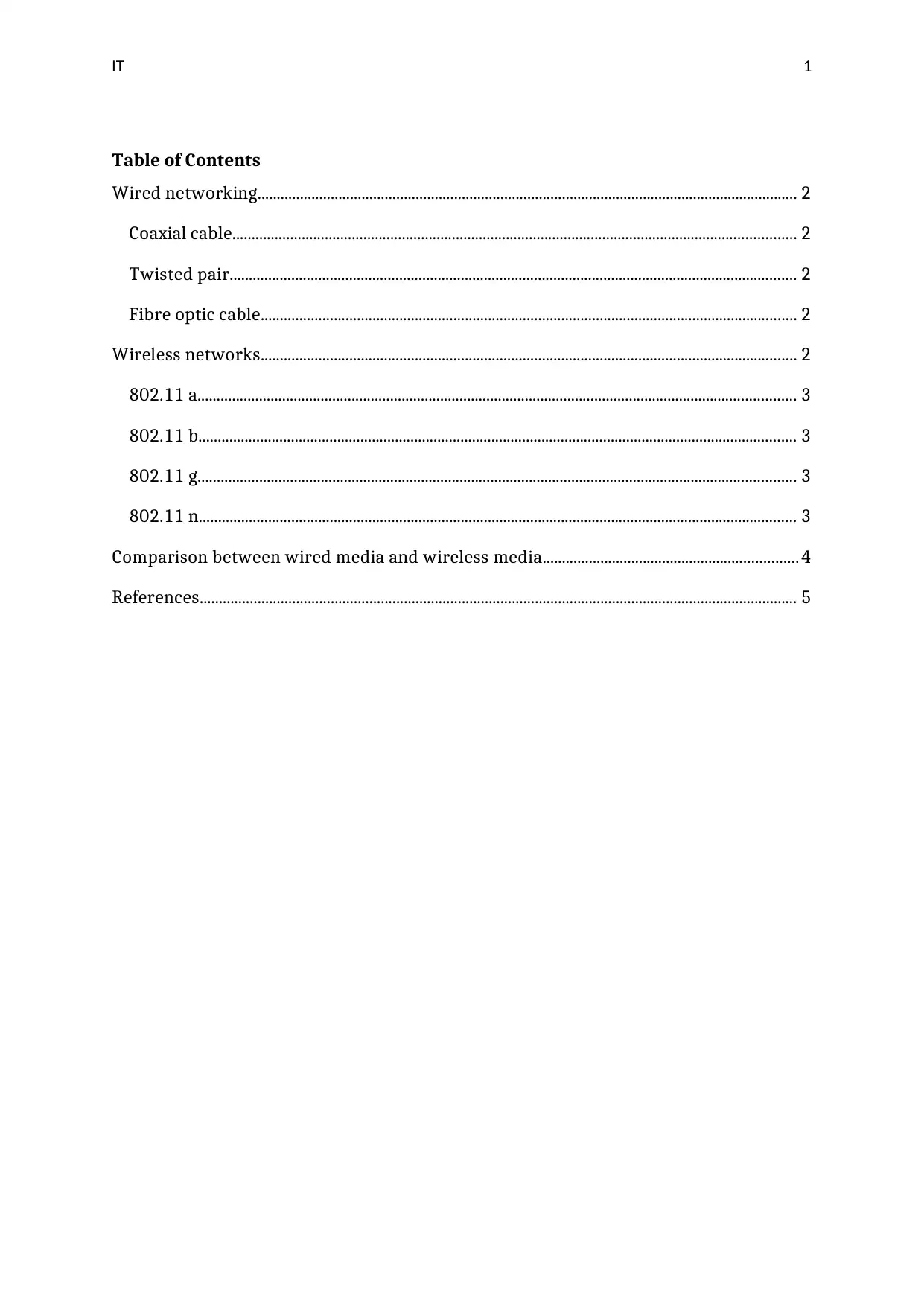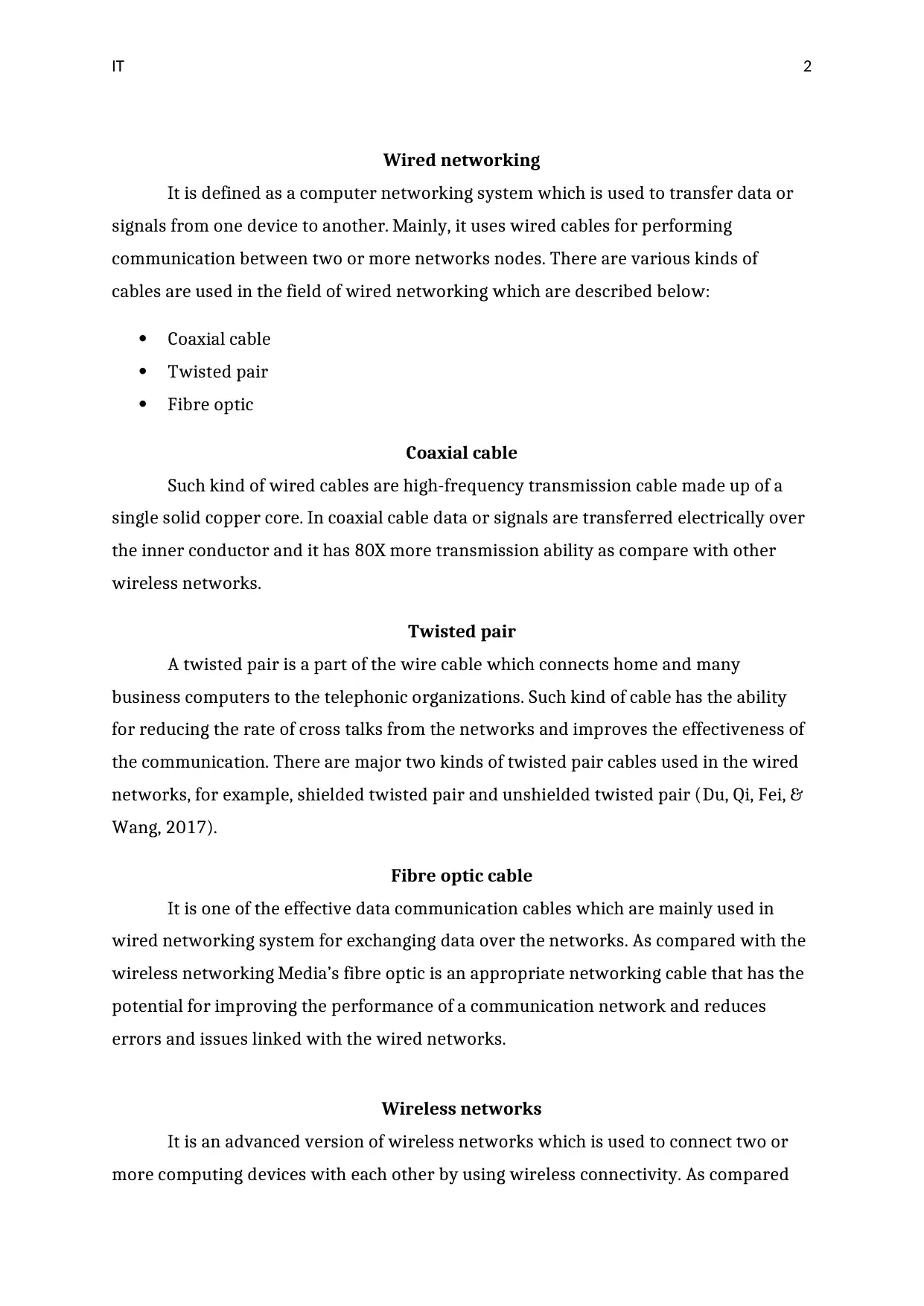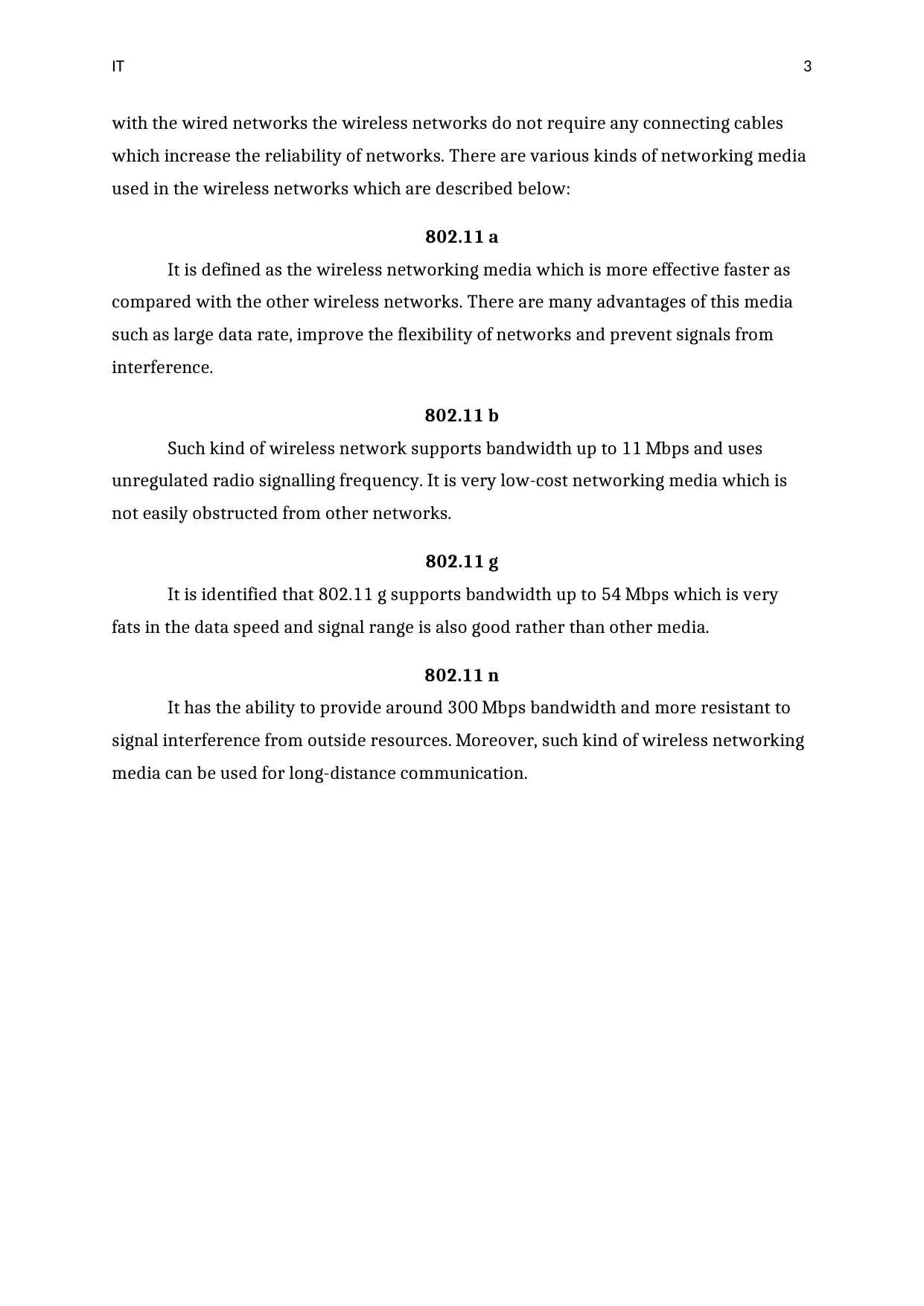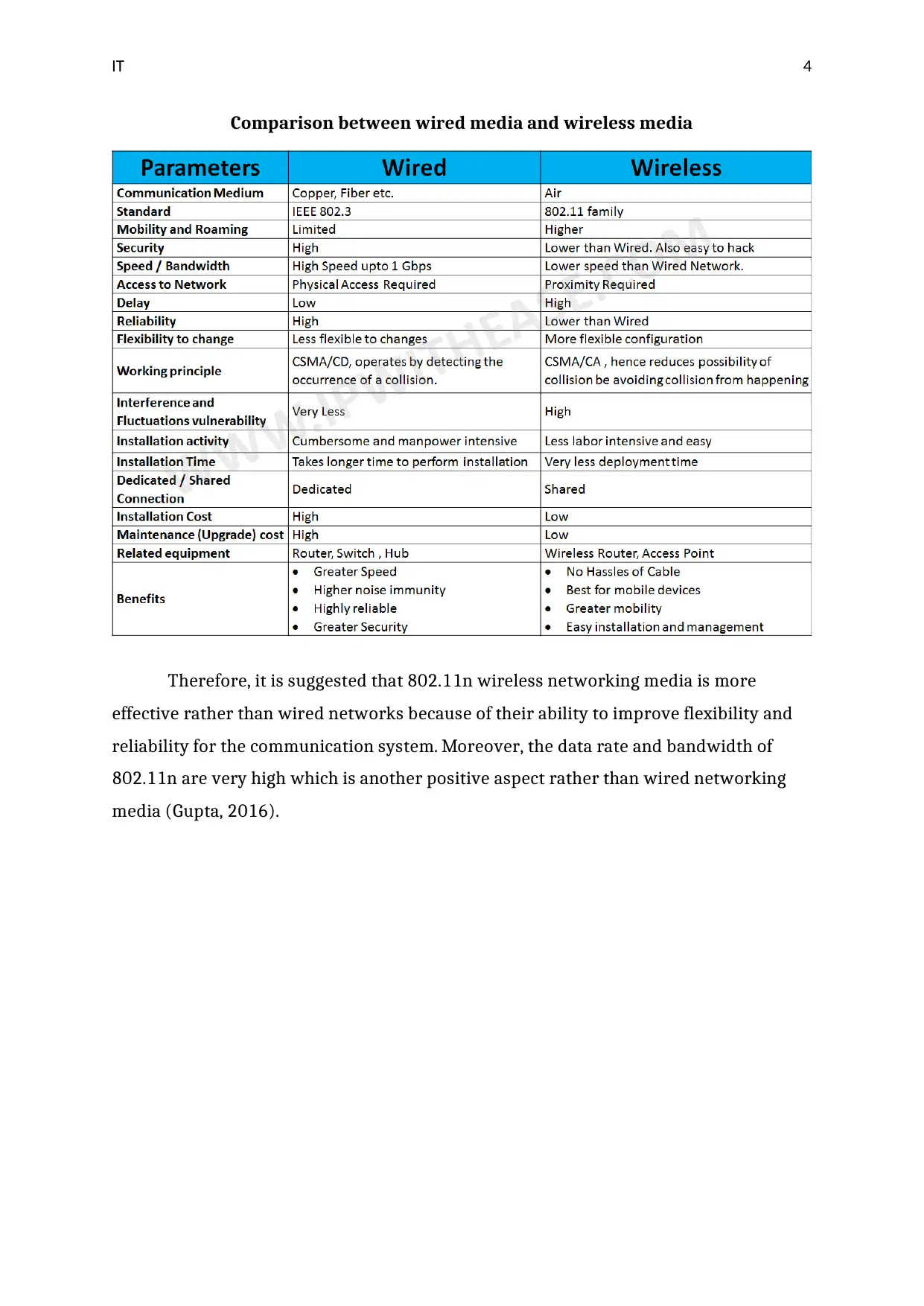Wired and Wireless Networking: A Comparative Analysis (IT 005 Module)
VerifiedAdded on 2022/11/17
|6
|675
|175
Report
AI Summary
This report compares wired and wireless networking technologies, focusing on coaxial cable, twisted pair, and fiber optic for wired connections, and 802.11 a, b, g, and n standards for wireless networks. It examines the characteristics of each, including data transfer rates, bandwidth, and signal interference. The report highlights the advantages and disadvantages of each medium, providing a comprehensive analysis of their performance and suitability for various applications. Ultimately, the report concludes that 802.11n wireless networking media is more effective due to its improved flexibility and reliability, along with high data rates and bandwidth, supported by two peer-reviewed sources, Du, Qi, Fei, & Wang (2017) and Gupta (2016).

IT 0
Wired and Wireless Networking
Wired and Wireless Networking
Paraphrase This Document
Need a fresh take? Get an instant paraphrase of this document with our AI Paraphraser

IT 1
Table of Contents
Wired networking............................................................................................................................................ 2
Coaxial cable.................................................................................................................................................. 2
Twisted pair................................................................................................................................................... 2
Fibre optic cable........................................................................................................................................... 2
Wireless networks........................................................................................................................................... 2
802.11 a........................................................................................................................................................... 3
802.11 b........................................................................................................................................................... 3
802.11 g........................................................................................................................................................... 3
802.11 n........................................................................................................................................................... 3
Comparison between wired media and wireless media..................................................................4
References........................................................................................................................................................... 5
Table of Contents
Wired networking............................................................................................................................................ 2
Coaxial cable.................................................................................................................................................. 2
Twisted pair................................................................................................................................................... 2
Fibre optic cable........................................................................................................................................... 2
Wireless networks........................................................................................................................................... 2
802.11 a........................................................................................................................................................... 3
802.11 b........................................................................................................................................................... 3
802.11 g........................................................................................................................................................... 3
802.11 n........................................................................................................................................................... 3
Comparison between wired media and wireless media..................................................................4
References........................................................................................................................................................... 5

IT 2
Wired networking
It is defined as a computer networking system which is used to transfer data or
signals from one device to another. Mainly, it uses wired cables for performing
communication between two or more networks nodes. There are various kinds of
cables are used in the field of wired networking which are described below:
Coaxial cable
Twisted pair
Fibre optic
Coaxial cable
Such kind of wired cables are high-frequency transmission cable made up of a
single solid copper core. In coaxial cable data or signals are transferred electrically over
the inner conductor and it has 80X more transmission ability as compare with other
wireless networks.
Twisted pair
A twisted pair is a part of the wire cable which connects home and many
business computers to the telephonic organizations. Such kind of cable has the ability
for reducing the rate of cross talks from the networks and improves the effectiveness of
the communication. There are major two kinds of twisted pair cables used in the wired
networks, for example, shielded twisted pair and unshielded twisted pair (Du, Qi, Fei, &
Wang, 2017).
Fibre optic cable
It is one of the effective data communication cables which are mainly used in
wired networking system for exchanging data over the networks. As compared with the
wireless networking Media’s fibre optic is an appropriate networking cable that has the
potential for improving the performance of a communication network and reduces
errors and issues linked with the wired networks.
Wireless networks
It is an advanced version of wireless networks which is used to connect two or
more computing devices with each other by using wireless connectivity. As compared
Wired networking
It is defined as a computer networking system which is used to transfer data or
signals from one device to another. Mainly, it uses wired cables for performing
communication between two or more networks nodes. There are various kinds of
cables are used in the field of wired networking which are described below:
Coaxial cable
Twisted pair
Fibre optic
Coaxial cable
Such kind of wired cables are high-frequency transmission cable made up of a
single solid copper core. In coaxial cable data or signals are transferred electrically over
the inner conductor and it has 80X more transmission ability as compare with other
wireless networks.
Twisted pair
A twisted pair is a part of the wire cable which connects home and many
business computers to the telephonic organizations. Such kind of cable has the ability
for reducing the rate of cross talks from the networks and improves the effectiveness of
the communication. There are major two kinds of twisted pair cables used in the wired
networks, for example, shielded twisted pair and unshielded twisted pair (Du, Qi, Fei, &
Wang, 2017).
Fibre optic cable
It is one of the effective data communication cables which are mainly used in
wired networking system for exchanging data over the networks. As compared with the
wireless networking Media’s fibre optic is an appropriate networking cable that has the
potential for improving the performance of a communication network and reduces
errors and issues linked with the wired networks.
Wireless networks
It is an advanced version of wireless networks which is used to connect two or
more computing devices with each other by using wireless connectivity. As compared
⊘ This is a preview!⊘
Do you want full access?
Subscribe today to unlock all pages.

Trusted by 1+ million students worldwide

IT 3
with the wired networks the wireless networks do not require any connecting cables
which increase the reliability of networks. There are various kinds of networking media
used in the wireless networks which are described below:
802.11 a
It is defined as the wireless networking media which is more effective faster as
compared with the other wireless networks. There are many advantages of this media
such as large data rate, improve the flexibility of networks and prevent signals from
interference.
802.11 b
Such kind of wireless network supports bandwidth up to 11 Mbps and uses
unregulated radio signalling frequency. It is very low-cost networking media which is
not easily obstructed from other networks.
802.11 g
It is identified that 802.11 g supports bandwidth up to 54 Mbps which is very
fats in the data speed and signal range is also good rather than other media.
802.11 n
It has the ability to provide around 300 Mbps bandwidth and more resistant to
signal interference from outside resources. Moreover, such kind of wireless networking
media can be used for long-distance communication.
with the wired networks the wireless networks do not require any connecting cables
which increase the reliability of networks. There are various kinds of networking media
used in the wireless networks which are described below:
802.11 a
It is defined as the wireless networking media which is more effective faster as
compared with the other wireless networks. There are many advantages of this media
such as large data rate, improve the flexibility of networks and prevent signals from
interference.
802.11 b
Such kind of wireless network supports bandwidth up to 11 Mbps and uses
unregulated radio signalling frequency. It is very low-cost networking media which is
not easily obstructed from other networks.
802.11 g
It is identified that 802.11 g supports bandwidth up to 54 Mbps which is very
fats in the data speed and signal range is also good rather than other media.
802.11 n
It has the ability to provide around 300 Mbps bandwidth and more resistant to
signal interference from outside resources. Moreover, such kind of wireless networking
media can be used for long-distance communication.
Paraphrase This Document
Need a fresh take? Get an instant paraphrase of this document with our AI Paraphraser

IT 4
Comparison between wired media and wireless media
Therefore, it is suggested that 802.11n wireless networking media is more
effective rather than wired networks because of their ability to improve flexibility and
reliability for the communication system. Moreover, the data rate and bandwidth of
802.11n are very high which is another positive aspect rather than wired networking
media (Gupta, 2016).
Comparison between wired media and wireless media
Therefore, it is suggested that 802.11n wireless networking media is more
effective rather than wired networks because of their ability to improve flexibility and
reliability for the communication system. Moreover, the data rate and bandwidth of
802.11n are very high which is another positive aspect rather than wired networking
media (Gupta, 2016).

IT 5
References
Du, D., Qi, B., Fei, M., & Wang, Z. (2017). Quantized control of distributed event-triggered
networked control systems with hybrid wired-wireless networks
communication constraints. Information Sciences, 380, 74-91.
Gupta, S. (2016). A Comparative Analysis of Wired and Wireless Network
Architecture. International Journal of Emerging Trends in Research, 1(1), 05-11.
References
Du, D., Qi, B., Fei, M., & Wang, Z. (2017). Quantized control of distributed event-triggered
networked control systems with hybrid wired-wireless networks
communication constraints. Information Sciences, 380, 74-91.
Gupta, S. (2016). A Comparative Analysis of Wired and Wireless Network
Architecture. International Journal of Emerging Trends in Research, 1(1), 05-11.
⊘ This is a preview!⊘
Do you want full access?
Subscribe today to unlock all pages.

Trusted by 1+ million students worldwide
1 out of 6
Related Documents
Your All-in-One AI-Powered Toolkit for Academic Success.
+13062052269
info@desklib.com
Available 24*7 on WhatsApp / Email
![[object Object]](/_next/static/media/star-bottom.7253800d.svg)
Unlock your academic potential
Copyright © 2020–2025 A2Z Services. All Rights Reserved. Developed and managed by ZUCOL.




